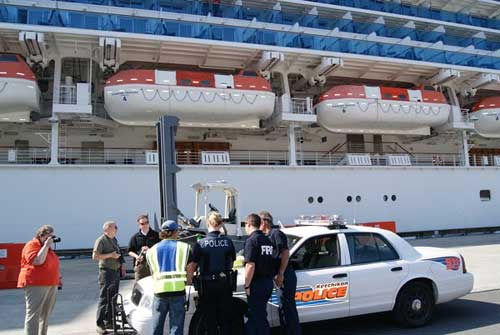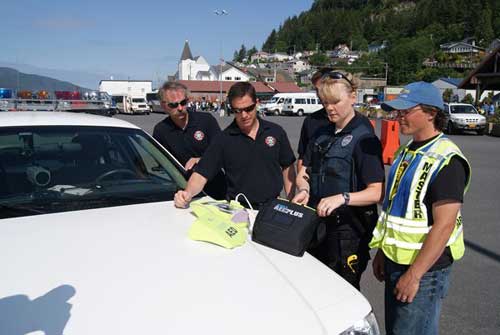 the Port-of-Ketchikan and in KPD Cruisers July 30, 2010
The cost of the AEDs was about $10,000, with the USDA picking up 55%, the State of Alaska contributing $2000, and the remainder being paid by the city of Ketchikan Fire Department, about $2,500.  Lt to Rt. KFD Firefighter/Medic Mike Moyer, KFD Training Officer/Paramedic Terry Roberts, Obscured is KFD Captain/Paramedic James Kleinschmidt, KPD Police Officer Natalie White, and Asst. Harbor Master Nick Burns. Photograph courtesy Ketchikan Fire Department
The program is coordinated by a Steering Committee comprised of a representative from each of the following agencies: Section of Community Health and EMS; Interior Region EMS Council; Inc.; Southeast Region EMS Council, Inc.; Southern Region EMS Council, Inc.; Maniilaq Association EMS; Norton Sound Health Corporation EMS; Yukon-Kuskokwim Health Corporation Injury Prevention and EMS; and the North Slope Borough EMS Program. Collaberative Effort: These grants are vetted several times as they compete for State and Federal funds. One of the variables working for Ketchikan was the strong collaboration between the Police and Fire departments. Putting AEDs in police cars is not a new idea, but it is a model that has had success across the nation. The places AEDs work best are those having progressive systems with on-going training programs and the ability to cross-train personnel. We have several Police Officers that have been trained to the EMT-1 level by the Fire Department. Police units frequently arrive on scene prior to EMS arrival. The pieces are in place for these machines to make a difference in our community. What is an AED? Automatic External Defibrillators (AEDs) are devices that, when connected to a victim of cardiac arrest, can automatically analyze electrical problems within the heart and, if it detects a "shockable heart rhythm", will automatically deliver a brief electric shock to the heart. This may enable the heart's natural pacemaker to regain control and establish a normal heart rhythm. Thousands of lives have been saved since AEDs have been placed in service around the country. External Defibrillators: External defibrillators are used in hospitals and by Emergency Medical Service (EMS) providers. Now AEDs are being used outside of medical environments as they become safer, easier to use, and more affordable. You've probably seen AEDs in various locations around Ketchikan. Around the country, AEDs have become standard equipment in airports, convention centers, health clubs, malls and other public facilities. Strategically placed, AEDs allow non-medical people to use them successfully with little training and sometimes no training at all.  Photograph courtesy Ketchikan Fire Department
Ten years ago, Alaska's rural EMS community was in crisis due to aging infrastructure. The Code Blue Project was established to provide essential EMS equipment by leveraging limited state dollars with funding from other non-traditional sources. This influx of resources has helped provide patient care and training equipment; patient transport equipment and communication needs. This allows emergency responders to do their jobs safely and more effectively. How it Works: Requests for funding are reviewed and approved at both the local and regional level before being scrutinized by the State's Code Blue Steering Committee. The Committee consists of representatives from each of the seven EMS regions and the State EMS Office. From this collaborative process, one prioritized list is made annually of essential EMS equipment that addresses Alaska's most critical needs. During the past ten years, a $3 million investment from the State of Alaska served as the catalyst for additional grant monies, yielding $15 million in capital projects. What Code Blue Has Accomplished: The variety of projects reflects the vast geographical and environmental differences in Alaska. Ambulances, snow machines, and ATVs with patient transport sleds and carts, boats equipped with first responder gear, and other unique patient transport vehicles are funded; along with cardiac monitors, radios, oxygen delivery systems, and pediatric equipment. Code Blue Partners: State of Alaska
On the Web:
Source of News:
Publish A Letter in SitNews Read Letters/Opinions
|